
Online courses are a great way to learn new skills and explore new interests. With so many options available, you can find a course that fits your needs and learning style. So whether you're looking to improve your professional skills or explore a new hobby, online courses can help you achieve your goals. This post will discuss the benefits of online courses and offer some tips for choosing the right course for you. We'll also highlight some of our favorite online courses for learning new skills. So whether you're just starting or looking to expand your horizons, read on for advice on how to get the most out of online learning!
According to new research, learning new skills is more complex than it used to be. In the past, people could pick up new skills quickly and easily. However, today's learners find it more challenging to retain further information and apply it to their lives. There are several possible explanations for this trend.
First, the sheer amount of information available today can be overwhelming. With so many sources of information, it can be hard to know where to start. Second, the pace of change is faster than ever before. As technology and society evolve, new skills are needed to keep up.
Finally, our attention spans are shorter than they used to be. With constant distractions from our devices and busy lives, it can be hard to focus on learning something new. Despite these challenges, it's still important to learn new skills and keep up with the changing world. With a bit of effort, anyone can overcome learning difficulties in the 21st century.
How online courses can help you learn new skills
First, online courses are flexible and convenient. You can usually choose when and where you want to study. This means you can fit learning into your busy schedule. Second, online courses are often more affordable than traditional classroom courses.
With so many free and low-cost options available, there's no excuse not to learn something new. Third, online courses allow you to learn at your own pace. If you need more time to understand a concept, you can take as long as you need. Fourth, online courses offer a more personalized learning experience. You can usually choose the topics you want to learn about and find instructors who match your learning style.
Finally, online courses can improve your job prospects. In today's competitive job market, employers look for candidates with the latest skills and knowledge. You can show employers that you're willing to learn new things and stay up-to-date with the latest trends by taking online courses.
Increased flexibility and convenience.
Online courses offer increased flexibility and convenience for students who might not be able to attend traditional brick-and-mortar schools. Students can study at their own pace and on their schedule with online classes.
They also can choose from a wide range of courses that might not be offered at their local school. In addition, online courses often provide more affordable tuition rates than traditional schools. As a result, online courses are an essential option for many students.
Affordable prices and a variety of course options.
As we mentioned, online courses often have more affordable tuition rates than traditional schools. In addition, there are usually a variety of course options available online. This means finding a course that fits your needs and budget. With so many choices available, you're sure to find the right course for you.
The ability to learn at your own pace.
One of the most significant advantages of online courses is learning at your own pace. If you need more time to understand a concept, you can take as long as you need. This is a significant benefit for students who might feel overwhelmed in a traditional classroom setting. In addition, online courses often provide more personalized instruction than traditional classrooms. This means that you can find a course that fits your learning style.
We have improved job prospects.
In today's competitive job market, employers look for candidates with the latest skills and knowledge. You can show employers that you're willing to learn new things and stay up-to-date with the latest trends by taking online courses. This can give you a big advantage when you're applying for jobs.
In addition, online courses can help you develop the skills and knowledge you need for a particular job. So if you're looking to change careers, online courses can be a great way to get started.
Lifelong learning opportunities.
Finally, online courses offer lifelong learning opportunities. This means that you can take courses at any stage of your life, whether you're just starting or you're looking to make a career change. Online courses can help you learn new skills and knowledge that you can use in your personal life or career. In addition, online courses can help you stay up-to-date with the latest trends. This is especially important in today's ever-changing world.
As you can see, online courses offer several significant benefits. Online courses are a great option if you're looking for an affordable, flexible, and convenient way to learn. With so many choices available, you're sure to find the right course for you. So what are you waiting for? Start exploring online courses today!
Tips for finding the right online course
With so many online courses available, it can be hard to know where to start. Here are some tips for finding the right course for you:
1. Define your goals. What do you want to learn? How will this new skill help you in your career or personal life? Once you know what you want to achieve, you can start searching for courses that will help you reach your goals.
2. Consider your learning style. Do you prefer visual or auditory learning? Do you like to learn by doing, or do you prefer to read and write? There are online courses available for all types of learners. Consider how you learn best and look for courses that match your learning style.
3. Find a reputable source. Not all online courses are created equal. When you're looking for a course, find a reputable source. Check the instructor's credentials and reviews from other students before enrolling in a course.
4. Set aside time for learning. One of the great things about online courses is that you can usually study whenever and wherever you want. However, it's essential to set aside some dedicated time for learning. Make sure you have enough time in your schedule to complete the coursework and assignments.
5. Take advantage of resources. Many online courses come with various resources, such as forums, chat rooms, and online support. These resources can be beneficial when you're stuck or need some extra help.
Online courses are a great option, whether you're looking to learn something new for your job or personal life. You can find the right course and get the most out of online learning with a bit of effort!
With so many benefits to online courses, it's no wonder that they have become so popular in recent years. They provide increased flexibility and convenience and a variety of course options at affordable prices. You can learn at your own pace, making it more convenient for you, and receive a personalized learning experience. This can lead to improved job prospects and lifelong learning opportunities. If you are looking for ways to improve your skills and knowledge, online courses should be one of your top choices.
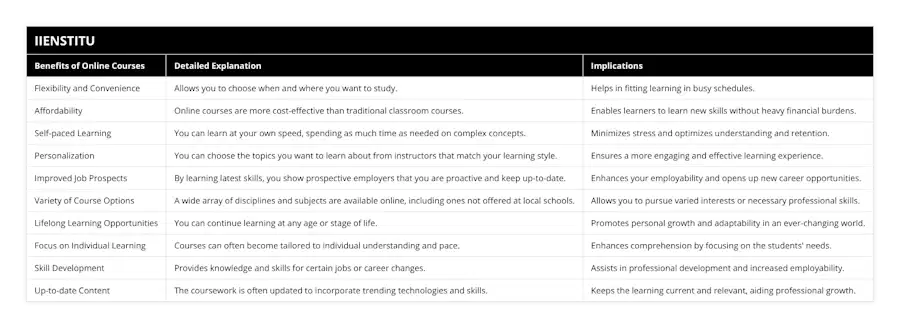
Frequently Asked Questions
What are the primary advantages and drawbacks of adopting e-learning in educational institutions?
Advantages of E-Learning in Educational Institutions
Flexibility and Accessibility
One primary advantage of adopting e-learning in educational institutions is increased flexibility and accessibility for students. E-learning platforms allow learners to access course materials at their convenience, catering to individuals with different learning speeds and schedules.
Cost-Effectiveness
E-learning can be more cost-effective than traditional classroom-based learning. Educational institutions save on expenses related to physical spaces, such as utilities and maintenance, while students can reduce costs associated with transportation, textbooks, and living on campus.
Personalized Learning Experience
E-learning platforms often provide personalized learning experiences tailored to individual students' needs, which can lead to higher engagement levels and better knowledge retention. Adaptive technologies, analytics, and immediate feedback mechanisms enable e-learning systems to support diverse learners effectively.
Drawbacks of E-Learning in Educational Institutions
Lack of Social Interaction
One primary concern associated with e-learning is the lack of social interaction between students and educators. Face-to-face interactions in traditional classrooms promote collaborative discussions, networking, relationship-building, and social skills development that may be lacking in e-learning environments.
Technical Issues and Digital Divide
E-learning requires access to adequate technology and a stable internet connection, which may not be available to every student. The digital divide can result in unequal access to quality education and learning experiences, exacerbating social and economic inequalities.
Limited Practical Exposure
Certain subjects and disciplines necessitate practical and hands-on experience for comprehensive learning. E-learning platforms may struggle to provide learners with sufficient practical exposure, impact their skill development, and limit their ability to apply knowledge in real-world situations.
In conclusion, the widespread adoption of e-learning within educational institutions presents both benefits and challenges. While it offers flexibility, cost-effectiveness, and personalized learning experiences, it can also result in a lack of social interactions and practical exposure and exacerbate the digital divide. Careful planning, investment in resources, and innovative approaches to e-learning can help strike a balance between these advantages and drawbacks, ensuring all students have equal access to quality education.
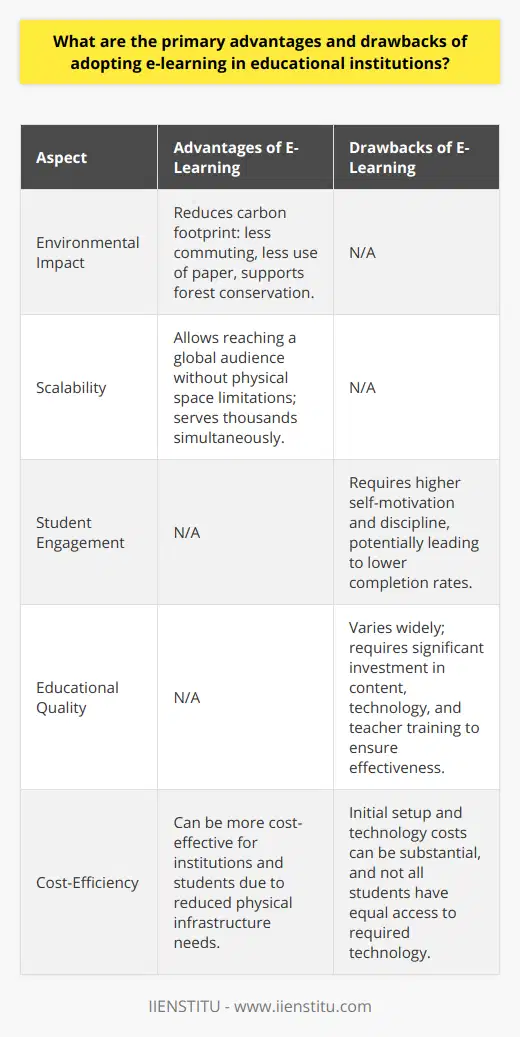
In what ways can face-to-face learning enhance a student's overall academic experience compared to online learning?
Personal Connection and Learning
Face-to-face learning can significantly enhance a student's overall academic experience compared to online learning by fostering personal connections and a shared learning environment. The opportunity to interact with peers and instructors in person allows for better communication and understanding of topics, by addressing immediate concerns or difficulties with ease. Moreover, nuances like facial expressions, body language, and tone of voice can aid in comprehending or conveying difficult concepts, ensuring effective knowledge transfer.
Collaborative Learning Experience
In-person learning environments promote a sense of community, helping students build strong interpersonal relationships and collaborative skills. Through group projects, discussions, or debates, students can exchange ideas, perspectives, and knowledge with their peers. Unlike online settings, where individuals may sometimes feel isolated or disconnected, face-to-face interactions provide an avenue for students to support each other's academic growth and engage in fruitful discussions. This collaboration can lead to more profound levels of understanding, as students learn from one another and develop critical thinking skills in the process.
Motivation and Accountability
Another advantage of face-to-face learning lies in its ability to boost motivation and accountability among students. Attending classes in person instills a sense of responsibility, routine, and discipline, which can contribute to better time management and academic success. Moreover, the presence of peers and instructors in a shared physical space can motivate students to actively participate in class discussions and remain engaged, knowing that their contributions are directly observed and acknowledged.
Immediate Feedback and Guidance
Finally, face-to-face learning enables students to receive immediate feedback and guidance from instructors. In-person interactions allow for quick clarifications, reducing the potential for misconceptions or misunderstandings. Educators can easily prioritize and address areas that need intervention, focusing on individual learning needs by observing students at work or through in-class assessments. This timely feedback provides students with an opportunity to improve their grasp of the material, honing their skills and contributing to a better academic experience overall.
In conclusion, face-to-face learning can greatly enhance a student's academic experience. Through personal connections, collaborative learning opportunities, increased motivation, and immediate feedback, in-person interactions provide an invaluable environment for academic success that is difficult to replicate in online learning.
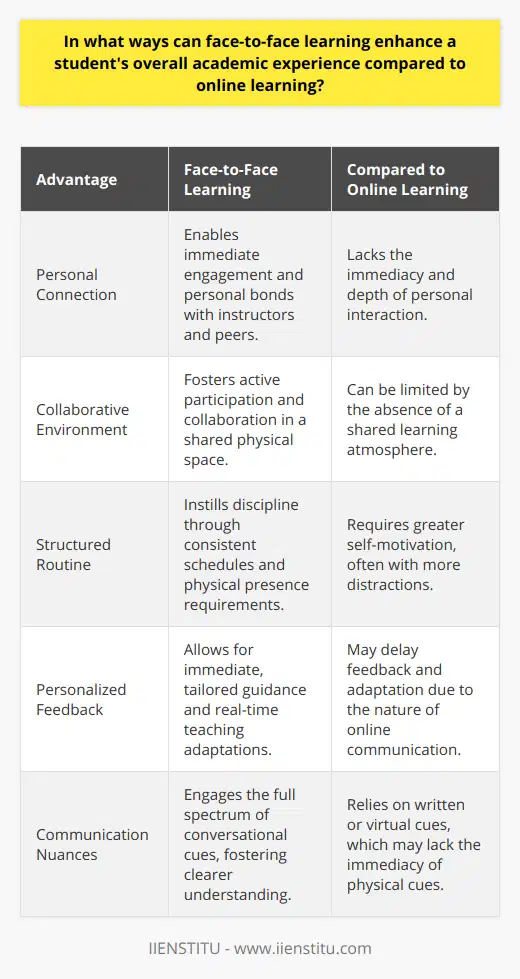
How does the importance of e-learning intersect with the evolving demands of modern education and the global workforce?
The Growing Significance of E-Learning
Indeed, e-learning plays a crucial role in addressing the ever-changing needs of both modern education and the global workforce. The rapid advancements in technology have led to new forms of learning, offering flexibility and convenience, which traditional methods of education may struggle to provide.
Accessibility and Affordability
A significant advantage of e-learning is its accessibility and affordability, which has made education more attainable for people worldwide. Learners can access courses, materials, and instructors without the constraints of location or time. This mode of learning has also reduced the costs associated with travel, accommodation, and other related expenses.
Skill Development Tailored to Industry Needs
E-learning provides a platform for designing curricula that cater specifically to the competencies required by various industries. Professionals can acquire skills in a targeted manner, thus expediting their growth and employability. Additionally, just-in-time learning modules enable workers to update their skills as new market trends or technologies emerge, ensuring they remain relevant in the global workforce.
Self-Paced and Adaptive Learning
E-learning platforms offer a self-paced and adaptable learning environment, catering to the unique needs and preferences of individual learners. This approach promotes a deeper understanding of the subject matter, as learners can revisit modules or seek clarification at their convenience. Furthermore, analytics-driven insights can help instructors design personalized learning paths, enabling enhanced academic outcomes.
Interactivity and Collaboration
To facilitate interactive and collaborative learning, e-learning platforms channel various technologies, such as multimedia presentations, social media, or virtual classrooms. These tools foster collaboration among peers, enhancing both critical thinking and problem-solving skills. Consequently, learners build vital competencies that are highly sought after by employers.
Continuous Learning and Lifelong Education
Finally, e-learning contributes significantly to the concept of 'lifelong learning', where individuals continuously update their knowledge and skills throughout their professional lives. By granting ease of access, e-learning platforms catalyze the pursuit of ongoing growth and personal development.
In conclusion, the importance of e-learning has risen to prominence as a result of its unparalleled accessibility, focus on industry-specific skills, adaptability, interactivity, and promotion of continuous learning. Consequently, e-learning has become an essential tool to address the evolving demands of modern education and the global workforce.
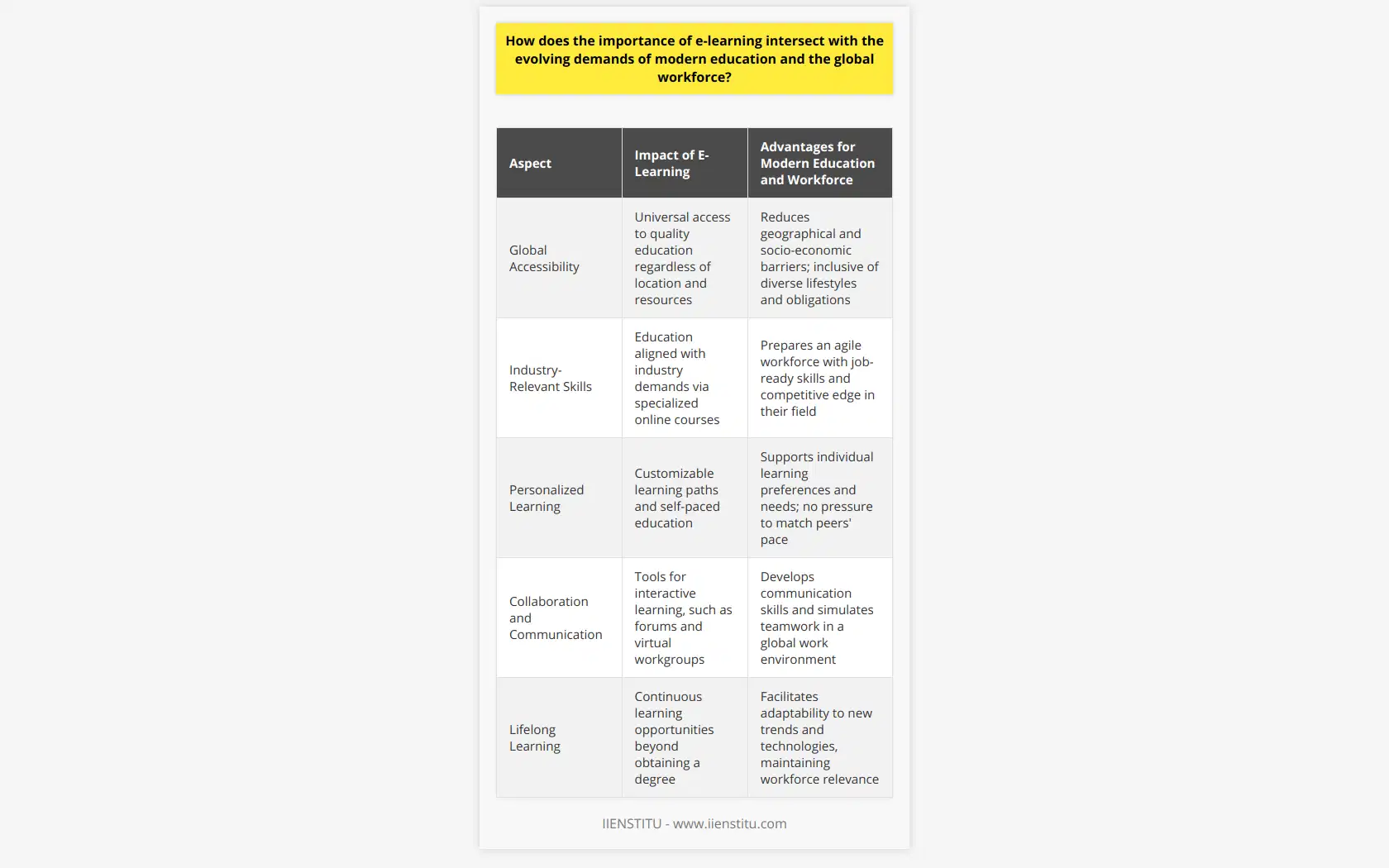
Why is online learning so important for the future of education?
The Necessity of Online Learning
Online learning has become a crucial element in the evolving landscape of education for various reasons. One of the most important aspects is its ability to provide accessibility to quality education for individuals who were previously unable to attend traditional institutions. This could be due to factors such as geographical barriers, time constraints, or financial limitations. With the proliferation and advancement of technology, online learning platforms are now able to deliver a wide range of educational content that can be accessed anytime and anywhere, democratizing access to knowledge and fostering a more inclusive educational environment.
Flexibility and Personalization
Another key advantage of online learning lies in its flexibility and adaptability to cater to diverse learning needs and preferences. Unlike traditional classroom settings, which can be rigid and standardized, online learning systems enable the creation of personalized learning paths and offer various options for learning activities and materials. This approach empowers learners to take charge of their education and progress at their own pace, increasing motivation and engagement. The incorporation of various multimedia formats further enhances the learning experience, catering to different learning styles and helping learners in retaining information more effectively.
Adapting to a Changing Workforce
The relevance of online learning extends beyond access and personalization, as it also reflects the changing dynamics of the workforce in today’s globalized and technology-driven economy. With the rapid emergence of new industries and job profiles, employees are required to constantly upskill and adapt to remain competitive and ensure career growth. Online learning programs have emerged as an indispensable tool for professionals to bridge skill gaps and acquire relevant competencies in a time- and cost-effective manner. The availability of various micro-credentials and industry-recognized certifications offers tangible proof of expertise, further enhancing the perceived value of online learning in the professional realm.
The Role of Data in Enhancing Learning Outcomes
Moreover, the analysis of data generated by learners' interactions with online learning platforms offers educators valuable insights into learners' progress and patterns, enabling them to identify areas of improvement and tailor their instruction accordingly. This data-driven approach not only facilitates timely interventions and support but also contributes to the development of more effective teaching strategies and learning materials. Ultimately, these advancements in data analysis and educational technology have the potential to significantly enhance learning outcomes for students in online learning environments.
In conclusion, the importance of online learning in the future of education can be attributed to its role in democratizing access, enabling personalization and addressing the needs of a constantly evolving workforce. Furthermore, the utilization of data-driven approaches is set to drive continuous improvements in learning outcomes and methodologies. Embracing and optimizing online learning within the educational ecosystem will undeniably contribute to a more inclusive, adaptive, and effective educational landscape in the long run.
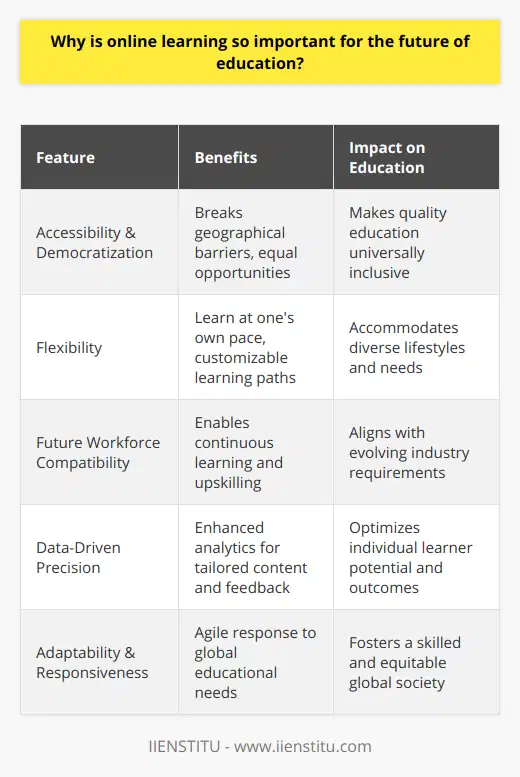
How can online courses provide a more personalized learning experience than traditional face-to-face learning?
Flexible and Adaptable Learning
Online courses offer a more personalized learning experience than traditional face-to-face learning as they enable learners to choose the content, pace, and schedule that fits their individual needs. This flexibility allows students to progress through the coursework at their own speed, without the pressure of adhering to a predetermined schedule.
Customizable Content
Additionally, online courses often provide a variety of learning materials to cater to different learning styles, such as text, images, audio, and videos. Instructors can customize the content to address specific needs, ensuring that students receive the appropriate level of support and interaction. As a result, online courses can provide a tailored learning experience for each student, reflecting their unique interests, goals, and learning preferences.
Immediate Feedback and Support
In online learning environments, students can access immediate feedback and support from their instructors and peers. Discussion boards, forums, and communication tools facilitate real-time interactions, helping students to clarify concepts, share ideas, and solve problems collaboratively. This access to immediate feedback enables learners to make timely adjustments to their learning strategies, enhancing the personalization of their learning experience.
Individualized Monitoring and Assessment
Online learning platforms often incorporate tools for monitoring and assessing individual students' progress. Instructors can use these features to track learners' engagement, participation, and understanding of course materials, identify strengths and weaknesses, and provide personalized guidance and feedback. This individualized approach to monitoring and assessment allows educators to address specific learning needs and support students in achieving their academic goals.
Autonomy and Self-Regulation
Lastly, online courses empower learners to take a more active role in their education by fostering autonomy and self-regulation. Students can set their goals, design their path, and evaluate their progress regularly. They can also leverage available resources, such as supplementary materials, tutorials, and expert support, to enhance their understanding and skills. This freedom to regulate their learning experience further contributes to a more personalized and relevant educational journey.
In conclusion, online courses offer a more personalized learning experience than traditional face-to-face learning by providing flexibility and adaptability, diverse and customizable content, immediate feedback and support, and tools for individualized monitoring and assessment. By fostering students' autonomy and self-regulation, online courses cater to individual needs, interests, and preferences, ultimately leading to a more effective and engaging educational experience.
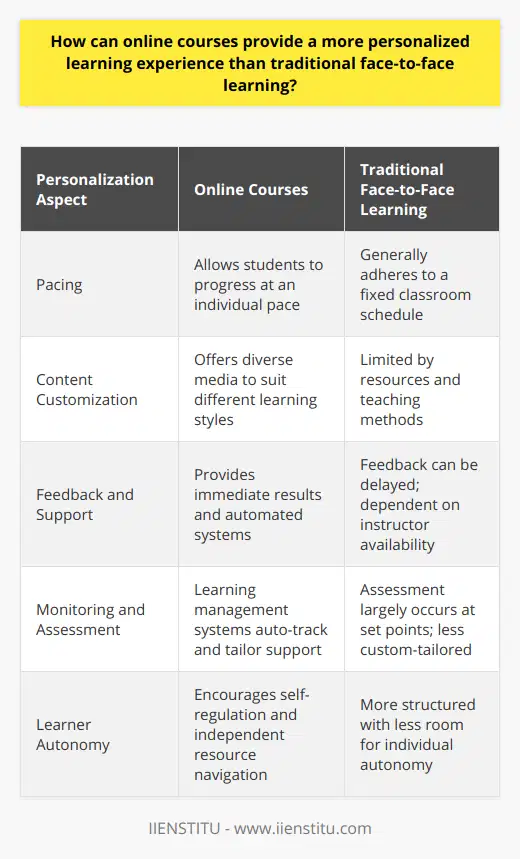
To what extent can online schooling positively impact a student's mental health and well-being compared to traditional educational settings?
Impact on Mental Health
Online schooling can positively impact a student's mental health and well-being to a significant extent compared to traditional educational settings. The flexibility provided by online learning allows students to attend classes at a pace that suits their individual learning styles and personal schedules. This feature has the potential to reduce stress levels, as students can accommodate other commitments more effectively while still engaging in their education.
Reduced Social Pressure
Another key aspect that contributes to improved mental health in online education is the reduced social pressure often experienced in traditional school environments. Educational settings are known to be a breeding ground for social anxiety, peer pressure, and bullying. The virtual nature of online schooling enables students to participate in educational activities without the fear of judgment or negative social interactions that could potentially harm their self-esteem and mental well-being. This safe environment allows for undisturbed focus on personal growth and academic achievement.
Tailored Learning
Furthermore, online schooling caters to a student's specific needs better since it often includes personalized learning plans and easy access to additional resources, such as tutorial videos and additional reading materials. The availability of such content promotes a growth mindset and fosters self-confidence, empowering students to develop a strong sense of self-efficacy. In turn, a positive self-image contributes to better mental health and resilience against stress in the long run.
Access to Mental Health Support
In addition, online schooling platforms often feature increased accessibility to mental health support services, as they recognize the importance of incorporating measures to ensure emotional and psychological wellness. These services can include dedicated counselors, mental health workshops, and virtual support groups that are readily available. This increased focus on mental health support can lead to earlier interventions and assistance, improving the overall well-being of students within the online schooling community.
Conclusion
In conclusion, the extent to which online schooling can positively impact a student's mental health and well-being is multifaceted, primarily due to its flexible nature, reduced social pressure, and resources for tailored learning and mental health support. While online education may not be a one-size-fits-all solution for all learning preferences and environments, it undoubtedly provides an avenue for students to achieve academic success within a framework that is more conducive to mental health and well-being compared to traditional educational settings.
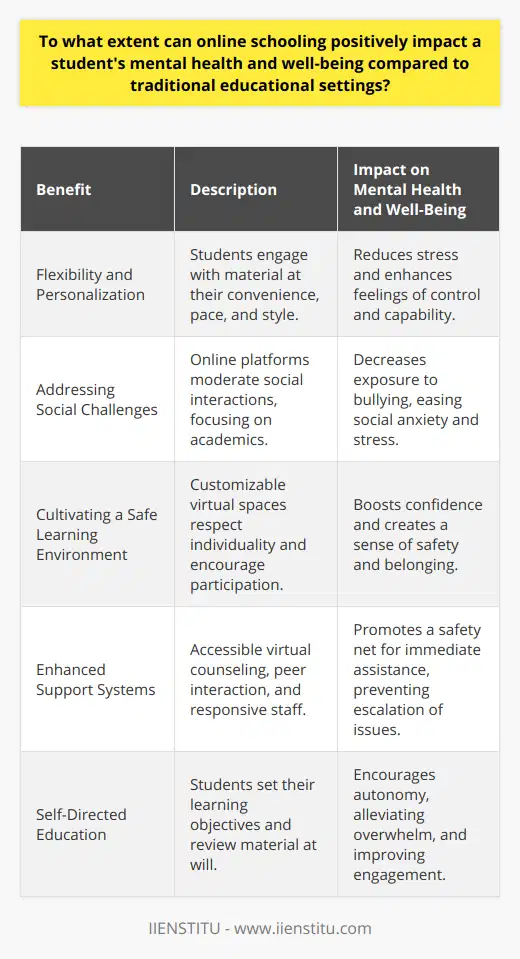
What are the key factors that contribute to the effectiveness of online learning compared to traditional learning environments?
Flexibility in Learning Schedules
One key factor that contributes to the effectiveness of online learning compared to traditional learning environments is the flexibility it offers in terms of learning schedules. Online learners can access course materials and resources at their own preferred time, making it easier for them to manage their personal and professional commitments alongside their education. This flexibility not only helps students adapt to the changing nature of their lives but also results in increased motivation and enhanced overall retention.
Personalized Learning Experience
Another crucial element of online learning is the ability to provide a personalized learning experience. Digital educational platforms come equipped with advanced analytics and adaptive algorithms that can identify students' strengths and weaknesses. They deliver the most appropriate resources and activities based on individual needs, making online learning more efficient and effective for each student. The traditional classroom, on the other hand, mainly focuses on a one-size-fits-all approach, which may not cater to every learner's unique needs.
Access to Diverse Resources
Online learning platforms also enable students to access a wide range of diverse resources, including video lectures, virtual simulations, interactive tutorials, and more. These multimedia learning materials provide an engaging and dynamic learning experience, leading to improved knowledge retention and better comprehension of complex concepts. In contrast, traditional learning environments primarily depend on textbooks and oral lectures, which may not be sufficient or appealing to all learners.
Prompt Feedback and Support
Furthermore, online learning fosters prompt feedback and continuous support, significantly enhancing the learning process. Students can quickly receive personalized feedback on their assignments and assessments, allowing them to address their weaknesses and make necessary improvements in real-time. Additionally, online learners can readily access support through discussion forums, live chats, and other communication tools, enabling them to solve issues and get help whenever needed. Traditional learning environments may not provide such consistent feedback and support, making the learning experience less effective.
Collaborative Learning Opportunities
Lastly, online learning enables students to connect and collaborate with their peers and instructors from diverse backgrounds, cultures, and perspectives. They can engage in thought-provoking discussions, share knowledge and experiences, and work on group projects, thereby improving not only their learning outcomes but also developing critical 21st-century skills like communication, teamwork, and leadership. Traditional learning environments can seldom match the scale and depth of collaboration offered by online learning platforms.
In conclusion, the effectiveness of online learning compared to traditional learning environments can largely be attributed to the flexibility it offers, personalized learning experiences, access to diverse digital resources, prompt feedback and support, and ample collaborative learning opportunities. As technology continues to transform the educational landscape, online learning is poised to become an indispensable part of modern education.
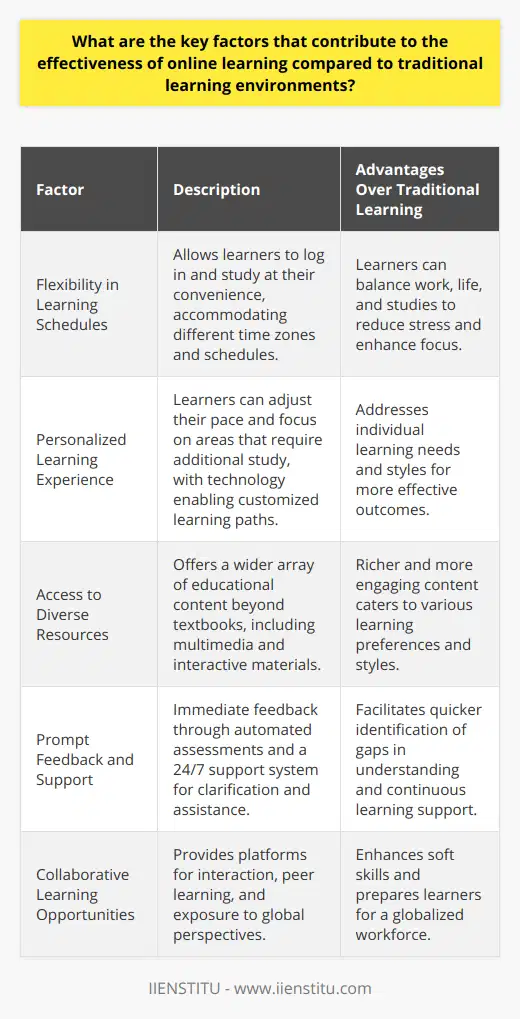
How does online education address the challenges of maintaining student engagement and motivation in comparison to conventional classroom settings?
Addressing Student Engagement in Online Education
Online education has become increasingly popular, addressing challenges of student engagement and motivation in various ways. One method involves utilizing technology to offer interactive multimedia content, making learning more enjoyable and stimulating. These tools include videos, games, quizzes, and simulations that foster active participation and deepen understanding of course material.
Fostering Collaboration through Online Platforms
Another way online education addresses student engagement is by providing opportunities to communicate and collaborate with peers and instructors. Through discussion boards, virtual group projects, and social media platforms, students can share ideas, ask questions, and receive feedback. This connectivity not only keeps students engaged but also nurtures a sense of community, often lacking in conventional classroom settings, and promotes intrinsic motivation for learning.
Flexible Pacing and Personalization
Online education lends itself to accommodate different learning preferences and abilities, offering customized learning experiences based on each student's needs. Students can access course materials at their own pace, allowing them to devote more time and attention to challenging topics without holding back their peers. Personalized learning paths, adaptive assessments, and real-time feedback enable learners to advance at their own optimal speed, enormously enhancing student motivation.
Facilitating a Growth Mindset through Technology
Furthermore, online education can cultivate a growth mindset in students, through exposure to diverse perspectives, and providing chances to reflect on their learning process. Monitoring progress through digital tracking tools like e-portfolios, learning analytics, and self-assessments can foster self-awareness and encourage students to take responsibility for their learning. This active involvement in the learning journey is vital for sustaining engagement and motivation.
Supporting Instructors to Enhance Student Engagement
Finally, online education platforms invest in training and supporting instructors to foster student engagement. Faculty development programs, online resources, and pedagogical guidance enable teachers to adopt various strategies to enhance online interactions, monitor student progress, and provide individualized support. An empowered and well-prepared instructor plays a crucial role in creating a motivating and engaging online learning environment.
In conclusion, online education can overcome the challenges of maintaining student engagement and motivation through innovative use of technology, fostering collaboration, personalization, promoting a growth mindset, and supporting instructors. Embracing these approaches, the virtual learning landscape can embody an educational setting that meets students' diverse needs and preferences, creating a thriving community of lifelong learners.
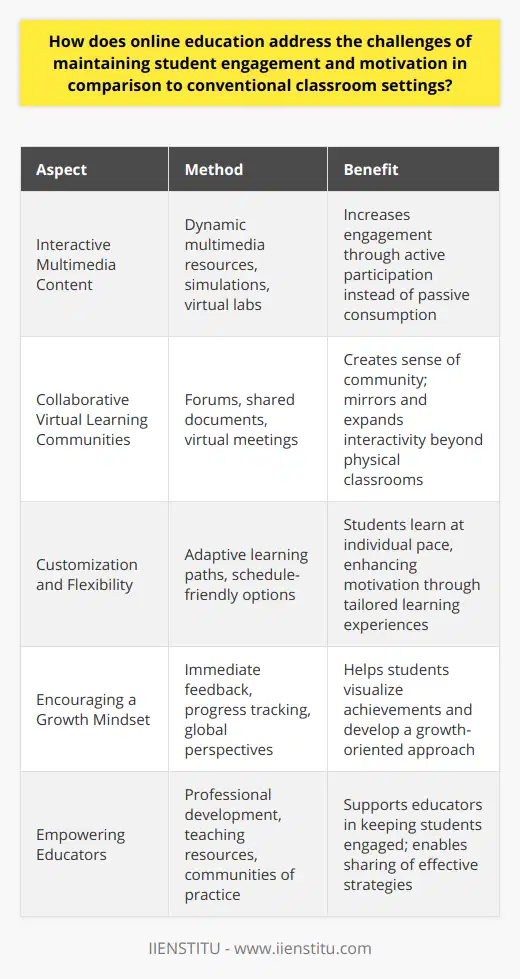
In terms of academic outcomes, how do online courses compare to traditional face-to-face courses in fostering critical thinking and problem-solving skills?
Comparison of Online and Traditional Courses
Academic Outcomes Assessment
In assessing the efficacy of online courses versus traditional face-to-face courses in fostering critical thinking and problem-solving skills, various factors and indicators of success must be considered. Research studies have reported mixed results, with some suggesting that online learning environments afford greater depth and complexity for the development of critical thinking skills, while others argue that the interpersonal interactions of face-to-face courses are more conducive to cultivating problem-solving capacity.
Online Learning Advantages
Several advantages of online learning environments have been identified in the development of critical thinking skills. Online courses often involve asynchronous communication, which allows students to reflect on their ideas and responses more thoughtfully, thereby fostering deeper critical analysis. Additionally, the incorporation of multimedia resources and interactive tools can enrich the learning experience, providing diverse perspectives and stimulating cognitive engagement. The flexibility and accessibility of online platforms also enable learners to interact with course material at their own pace, facilitating the absorption and application of complex concepts and problem-solving strategies.
Traditional Classroom Benefits
Alternatively, traditional face-to-face courses are thought to be more effective in promoting problem-solving due to the immediacy and dynamism of classroom interactions between students and instructors. The dialogue and debate that occur in traditional classes foster an environment where learners can ask questions, clarify points and engage with their peers and instructors in real-time, allowing for instantaneous feedback and support. Moreover, instructors are in a better position to assess students' understanding of concepts and provide tailored guidance to address challenges and obstacles in the learning process. Body language, tone and other non-verbal cues can also contribute to the transmission of knowledge, making traditional classroom settings a richer experience for complex skill development.
Mixed Modalities Approach
In light of the strengths and limitations of both online and traditional instructional modalities, a blended approach may offer the most effective means of nurturing critical thinking and problem-solving skills in students. By incorporating elements of both online and face-to-face learning experiences, educators can facilitate a rich, engaging and dynamic environment that optimizes the development of higher-order cognitive skills. Hybrid instructional models enable learners to benefit from the depth and flexibility of online resources, while also capitalizing on the real-time interaction and support that traditional classrooms provide.
Conclusion
Ultimately, the efficacy of online or traditional courses in cultivating critical thinking and problem-solving skills hinges on the quality and design of the educational experience. A blended approach that harnesses the strengths of both modalities is likely to lead to the most favorable academic outcomes in the development of these essential cognitive skills.
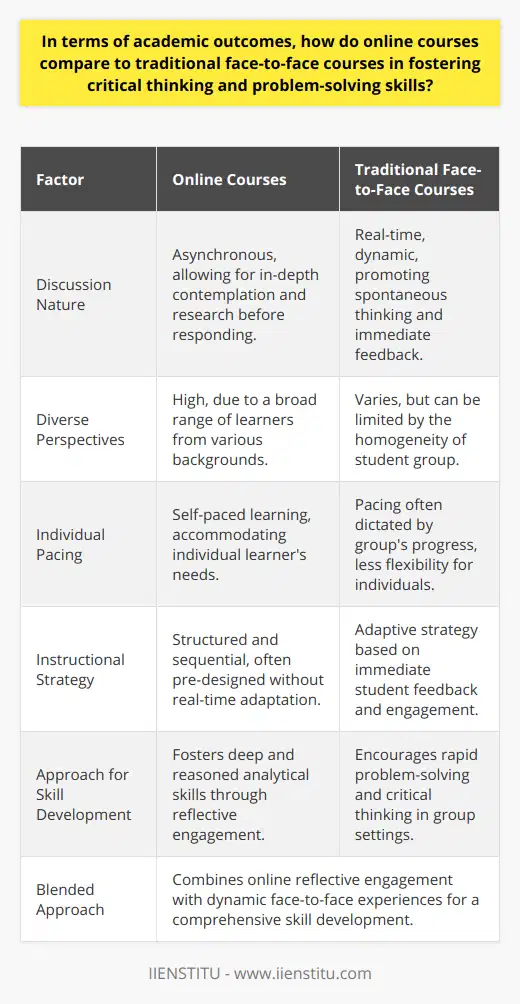
Why online education is better than traditional?
Advantages of Online Education
Accessibility and Flexibility
Online education offers accessibility and flexibility to learners, irrespective of their geographic location or time constraints. It allows students to attend classes, access course materials, and interact with peers and instructors through digital platforms. This convenience enables individuals to balance work, family and personal commitments alongside their education.
Cost-Effectiveness
Compared to traditional education, online programs often have lower tuition fees and eliminate additional expenses such as transportation, accommodation, and textbooks. Digital resources and open educational materials reduce the burden of costly course materials, making education more affordable for a larger audience.
Personalized Learning
Online education promotes self-paced learning, allowing students to progress at their own speed and revisit coursework when needed. This individualized approach caters to a wide range of learning styles, enabling learners to focus on their strengths and work on their weaknesses. Additionally, adaptive learning technologies can identify areas requiring improvement and adjust the teaching method accordingly.
Diverse Course Offerings
The abundance of online programs and courses provides a broader range of subject areas, catering to diverse interests and career aspirations. Many online institutions partner with renowned universities to deliver high-quality, accredited degrees. This enables students to access courses from prestigious institutions regardless of geographic restrictions.
Collaborative Learning Environment
Online platforms facilitate interaction between peers and instructors, fostering a collaborative learning environment. Technology-enabled tools, such as discussion forums and video conferencing, allow students to exchange ideas, share perspectives, and support each other's learning journeys. This global network enables the development of cross-cultural communication skills and expands learners' worldviews.
Digital Literacy Skills
Online education exposes learners to various digital tools, enhancing their technology prowess and preparing them for the increasingly digital workforce. The ability to navigate digital platforms, curate information from different sources, and engage in virtual collaboration are skills that will serve students well in their future careers.
In conclusion, online education surpasses traditional forms of learning in terms of accessibility, cost-effectiveness, personalized instruction, diversity in course offerings, opportunities for collaboration, and the development of digital skills. This innovative approach to education has the potential to address the needs of today's learners and better prepare them for an increasingly digital world.
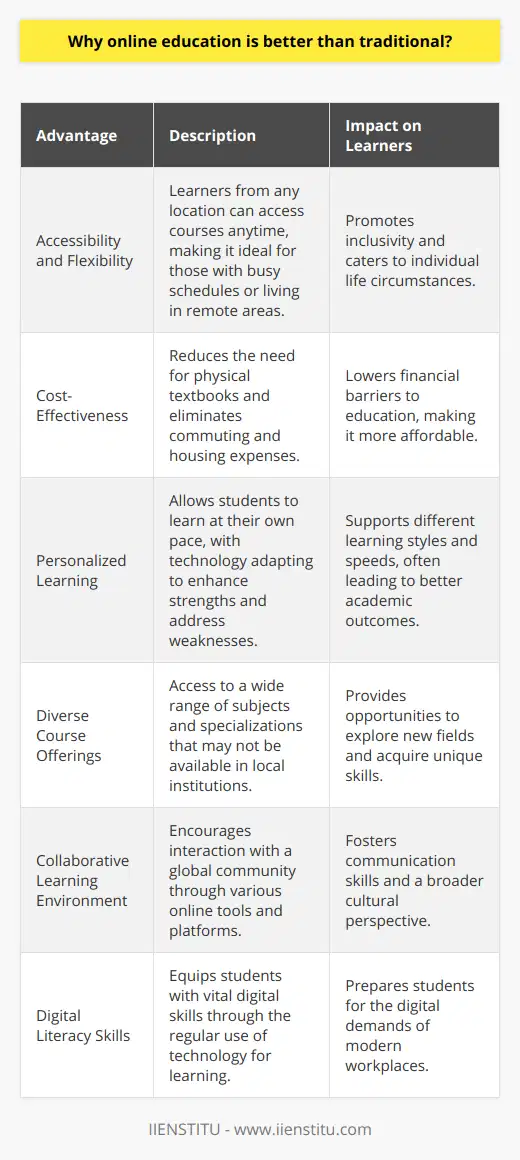
What is the most acceptable reasons to consider online education?
Accessible and Flexible Learning Environment
The most acceptable reason to consider online education is the increased accessibility and flexibility it offers to learners. Online education enables individuals who may have otherwise faced barriers, such as geographic location, physical disabilities, or time constraints, to access high-quality learning resources and interact with instructors and peers from diverse backgrounds. Through online platforms, learning becomes convenient as students can participate in virtual classrooms, access digital materials, and complete assignments at their own pace and schedule.
Lower Costs and Work-Life Balance
Furthermore, online education generally tends to be more affordable than traditional, on-campus programs. Lower tuition fees, minimal or no commuting and housing expenses, and the reduced need for textbooks or other course materials contribute to the cost-effectiveness of online learning. In addition to financial benefits, online education allows students to maintain a healthy work-life balance. Individuals in full-time employment, as well as those with family and other personal obligations, can pursue their educational goals without the need to quit their jobs or uproot their lives.
Self-Paced Learning and Skill Development
Another compelling reason for considering online education is that it fosters self-paced learning, which accommodates different learning speeds and styles. Students can review course materials and work on tasks at their own pace, enabling them to gain a deeper understanding of the subject matter. This empowerment in the learning process promotes the development of valuable skills such as time management, self-discipline, problem-solving, and digital literacy, which are vital for success in today's competitive job market.
Networking and Collaboration Opportunities
Finally, online education offers diverse opportunities for networking and collaboration. By engaging in online discussion forums, group projects, and virtual meetings, learners enhance their communication, teamwork, and project management skills. These experiences help students build global professional networks and expose them to new ideas and perspectives, thus expanding their horizons in their respective fields.
In conclusion, the most acceptable reasons to consider online education consist of increased accessibility and flexibility, lower costs, self-paced learning, skill development, and networking opportunities. Online education offers individuals the chance to pursue their educational aspirations without compromising on their personal and professional responsibilities. As technological advancements progress, online education will continue to evolve, providing even more reasons for its consideration.
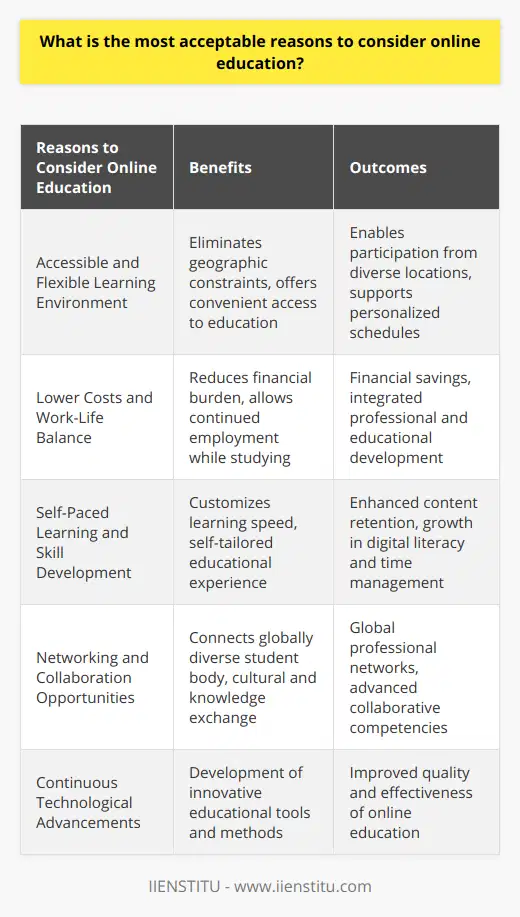
What is a benefit of online resources?
Accessibility of Information
One of the most significant benefits of online resources is the easy accessibility of information. A vast amount of knowledge on various subjects is available on the internet, which simplifies researching and learning new topics. With just a few clicks, anyone can access relevant data without any restrictions imposed by time or location.
Varied Source Material
Online resources also provide a diverse range of source materials. From academic papers to blog posts, users can find an abundance of information types, accommodating different learning styles and preferences. Such variety enables individuals to delve into multiple perspectives, resulting in a broader understanding of the subject matter.
Efficient and Cost-Effective
Online resources offer an efficient and cost-effective way to learn. Digital content is often quicker to locate than physical resources, such as books in a library, thus saving time for the user. Moreover, many online materials are freely available or provided at a minimal cost, eliminating the need for investing in pricey textbooks and other traditional educational materials.
Flexibility and Customization
Digital resources grant the user greater flexibility and customization. Unlike printed materials, online sources can be easily updated, ensuring that the information accessed is current and accurate. Additionally, users can tailor their learning experience according to their preferences, by choosing the medium and format that suits them best, be it interactive websites or downloadable e-books.
Facilitating Collaboration
Lastly, online resources provide platforms for collaboration and networking. Many websites offer discussion boards, forums, or comment sections, enabling users to exchange ideas, engage in intellectual debates, and build connections with likeminded individuals. Such interaction enriches the learning experience and fosters a sense of community among people who share common interests.
In conclusion, the availability, variety, efficiency, and interactivity of online resources contribute to their enormous benefit as an accessible and diverse source of information. These digital platforms cater to a wide array of learning styles and preferences, empowering users to broaden their knowledge base and engage in meaningful discussions with other individuals.
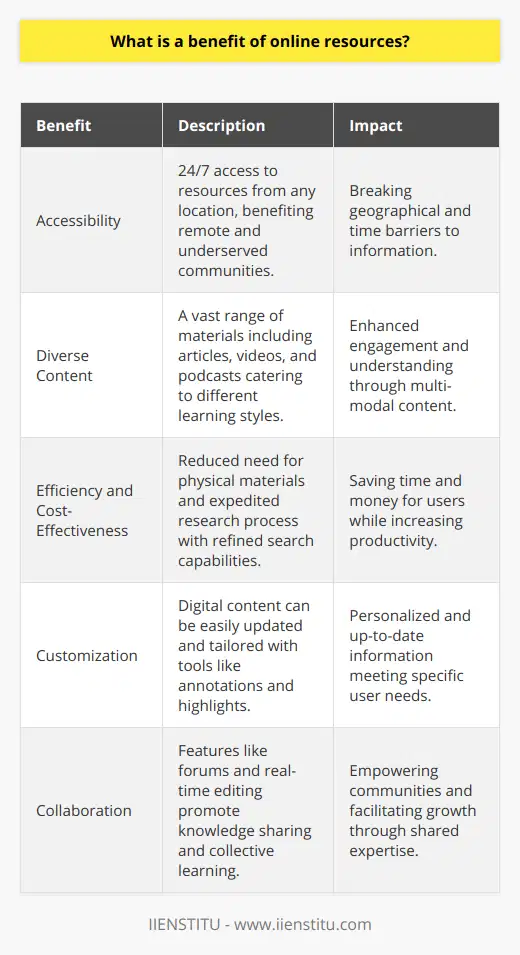
What are the implications of online learning on a student's ability to develop strong interpersonal and communication skills compared to traditional educational settings?
Impact of Online Learning on Interpersonal Skills Development
The growing prevalence of online learning has significantly impacted students' ability to develop strong interpersonal and communication skills in comparison to traditional educational settings. The online environment lacks the face-to-face communication and social interactions found in physical classrooms, which play a crucial role in honing students' communication and relationship-building abilities.
Reduced Opportunities for In-Person Interaction
In online courses, students have fewer opportunities to engage in in-person interactions, including group activities, discussions, or debates that are typical of traditional classrooms. These settings encourage collaboration, negotiation, and the exchange of ideas and perspectives, components that are vital in developing interpersonal and communication skills.
Limited Exposure to Non-Verbal Communication
Online learning also limits students' exposure to non-verbal communication, such as facial expressions, gestures, and body language. This aspect of communication is crucial in understanding and interpreting the feelings and emotions of others, ultimately fostering empathy and establishing rapport in social connections.
Challenges of Virtual Communication
Furthermore, virtual communication, predominantly text-based, often leads to misunderstandings or misinterpretations due to the absence of tone, inflection, or physical cues seen in face-to-face communication. Consequently, this can hinder students' ability to effectively convey their thoughts and respond appropriately to others in online discussions.
Necessity of Incorporating Collaborative Learning
To address this issue, educators must incorporate collaborative learning experiences in online courses to promote interactions among students. For example, incorporating group projects, video conferences, and interactive discussion boards can create opportunities for students to practice their communication and interpersonal skills in a virtual environment.
Importance of Blended Learning Approaches
Moreover, blended learning approaches, which combine online and face-to-face components, can help students reap the benefits of both traditional and digital learning environments. In these settings, students can maintain social interactions and develop interpersonal skills while also taking advantage of the flexibility and accessibility offered by online learning.
In conclusion, the implications of online learning on students' ability to develop strong interpersonal and communication skills hinge upon the incorporation of interactive and collaborative elements in the course design. By emphasizing the importance of social engagement and interaction in online learning, educators can ensure that students in the digital age continue to foster essential interpersonal and communication skills.
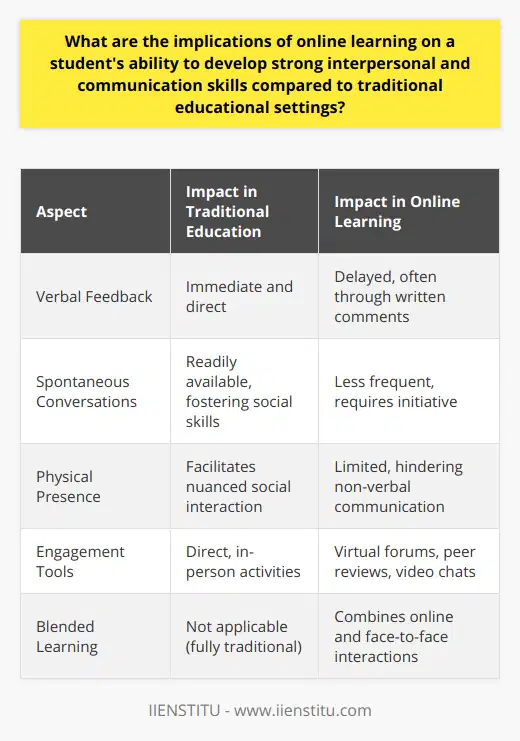
How do online courses ensure the integrity and credibility of educational assessments in comparison to face-to-face learning environments?
Ensuring Assessment Integrity in Online Courses
In recent years, online courses have been increasingly popular, raising questions about the integrity and credibility of educational assessments. When comparing online courses to face-to-face learning environments, several measures ensure the validity of online assessments.
Utilization of Technology-Driven Assessments
Many online courses employ technology-driven assessments designed for online learning environments, such as adaptive testing, multiple-choice questions, and computer-generated essays. These assessment methods offer objective evaluations and limit the scope for biases, guaranteeing a fair evaluation process.
Proctoring and Monitoring
Online courses often use proctoring services and monitoring tools, preventing and detecting instances of academic dishonesty. These services utilize remote proctors and tools like webcams to monitor students during online exams continually, ensuring fair and authentic assessment outcomes.
Use of Unique Identifiers
To verify that the individual enrolled in the course is the one taking the assessment, online platforms often use unique identifiers, such as usernames and passwords, combined with other types of authentication like security questions, biometrics, or facial recognition.
Feedback and Reflection
To maintain credibility in online assessments, many courses consistently provide feedback to the students, ensuring a continuous improvement process. This feedback helps students reflect on their performance, allowing them to make necessary adjustments and learn from the assessments.
Peer Reviews
Online courses can incorporate peer review into the assessment process, which provides multiple perspectives on the students' work to maintain credibility. This collaborative approach helps to ensure that the assessment outcomes are accurate and relevant to the learning goals.
Adapting Assessment Design
Given the differing nature of the learning environment, online courses may need to adapt assessment designs to account for potential challenges. This could involve altering assessment methods, offering flexibility in the evaluation timeline or creating alternative paths to reach learning outcomes, all contributing to the credibility of online assessments.
In conclusion, online courses ensure the integrity and credibility of educational assessments by utilizing a range of measures, including technology-driven assessment methods, proctoring services, monitoring tools, unique identifiers, providing feedback, incorporating peer reviews, and adapting assessment design. By employing these approaches, online learning environments can effectively achieve valid, fair, and authentic assessment outcomes.
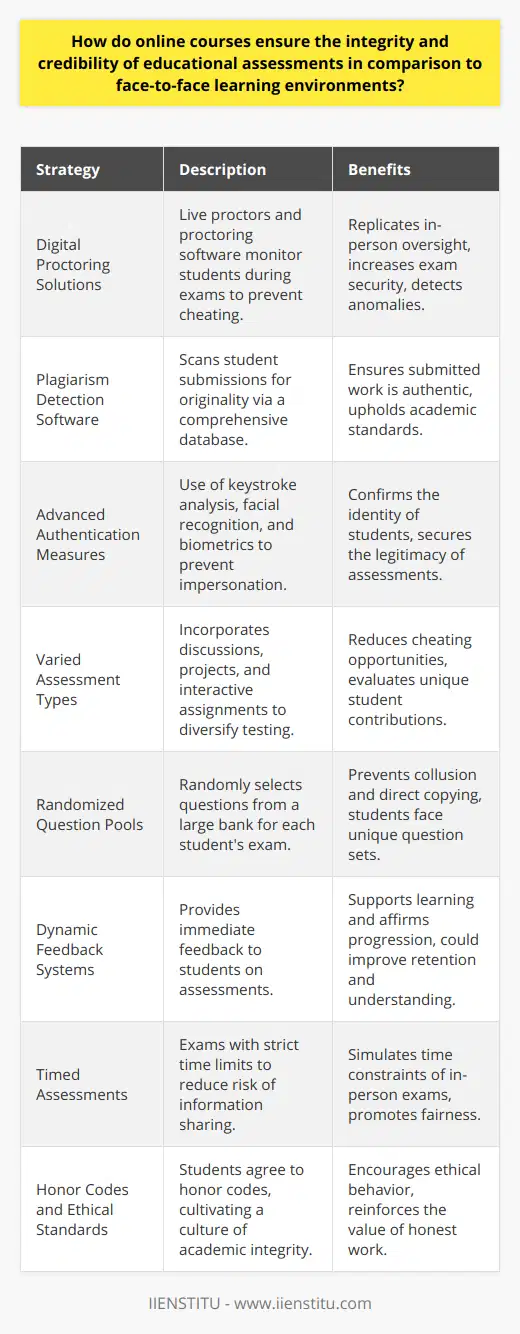
In terms of adaptability and flexibility, how does online education cater to the diverse needs of learners, as opposed to traditional classroom settings?
Addressing Diverse Learning Styles
In terms of adaptability and flexibility, online education holds a significant advantage over traditional classroom settings by catering to diverse learning styles. A crucial aspect of online learning is the opportunity for personalization, allowing learners to engage with the material at their own pace. This accommodates a broader range of individual needs, particularly for those who may require additional time or seek a more challenging experience.
Multiple Content Formats
Online education also facilitates access to a variety of content formats, such as videos, podcasts, articles, and interactive activities. This supports the diverse preferences and cognitive needs of learners, including visual, auditory, and kinesthetic learning styles. Contrarily, traditional classrooms often rely primarily on lectures and textbooks, which may be insufficient for some students to effectively grasp the subject matter.
Enhancing Collaboration and Engagement
Furthermore, online learning platforms provide versatile collaboration tools, such as discussion forums, video calls, and peer-review systems. These encourage participation and interaction in ways that traditional classrooms may not offer. Online education enables learners with different cultural backgrounds, geographical locations, or disabilities to overcome barriers in sharing perspectives and enhancing their understanding of the subject matter.
Flexible Scheduling and Learning Environment
An essential feature of online education is the flexibility it offers in terms of scheduling and accessibility. This allows learners to manage their progress without compromising other responsibilities, such as work, family, or social commitments. Moreover, learners can select an environment conducive to their preferences, whether at home, in a public library, or another suitable location. In contrast, traditional classroom settings often impose strict schedules and require consistent attendance in specific environments, leading to potential conflicts and distractions for many individuals.
Continuous Skill Development Opportunities
Online education enables access to an extensive array of resources, empowering learners to continually develop their skills and knowledge. In comparison to traditional classrooms, which may be constrained by the expertise of a single educator or the availability of course offerings, online platforms offer dynamic learning experiences. These can be tailored to suit individual needs, foster ongoing growth, and address emerging trends or technologies in various fields.
In conclusion, online education offers significant advantages over traditional classroom settings in terms of adaptability and flexibility. By accommodating diverse learning styles and needs, online platforms allow learners to engage with content in multiple formats, collaborate with peers from different backgrounds, manage their schedules, and access various resources to enhance their skill development. These benefits make online education an increasingly valuable option for addressing the diverse needs of learners.

What are the benefits of taking an online course compared to a traditional classroom setting?
Flexibility and Convenience
One intrinsic benefit of enrolling in an online course is the flexibility and convenience it offers. Traditional classrooms require on-site attendance, adhering to a specified timetable. On the other hand, online courses allow learners to study from anywhere, at any time. This increased flexibility can significantly benefit those who have other commitments, such as work or family responsibilities.
Personal Pacing
Another advantage of online courses is the opportunity for students to learn at their own pace. In contrast to the speed-focused approach in traditional classrooms, online learning accommodates different learning styles and speeds. Students can take the time they need to fully understand complex concepts, or move more quickly through material they grasp easily.
Technology Orientation
Online courses also allow learners to become more comfortable with using technology. The digital nature of these courses helps students develop skills like navigating digital platforms, understanding online etiquette, and solving technical issues. These skills are becoming increasingly important in our technology-driven world.
Cost Efficiency
Finally, online courses often present a more cost-effective option than traditional classrooms. This may stem from eliminated costs related to commuting, housing, meal plans, or textbook purchases. The reduced financial burden can make education more accessible to a larger population.
In conclusion, the benefits of taking an online course lie in the flexibility, personalised pacing, technology orientation, and cost efficiency it offers. While these advantages may not replace the benefits of traditional classroom settings entirely, they do offer a robust and promising alternative for many learners.
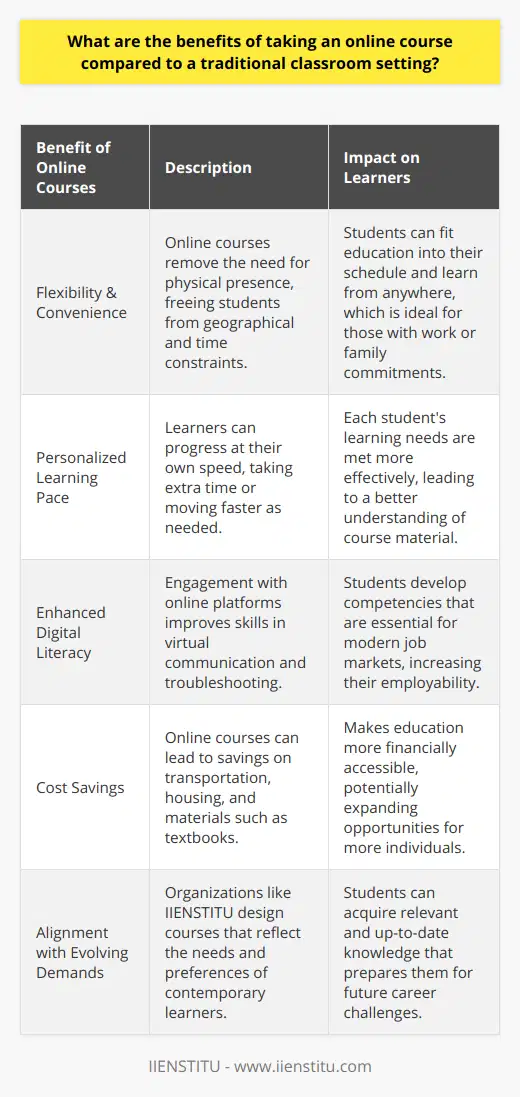
Is online learning as effective as face-to-face learning in terms of knowledge retention and skill development?
Online Learning and Retention
The efficacy of online learning versus face-to-face learning largely depends on multiple factors. A principle factor is the individual's learning style. Certain people find online learning more conducive, while others thrive in physical classrooms.
Knowledge Retention
Regarding knowledge retention, studies often depict mixed results. Some studies suggest online learners display equal or superior retention rates compared to traditional learners. On the contrary, other research points to lower retention rates among online students due to the lack of social interaction and peer pressure.
Engagement Factor
The level of engagement in the learning process also plays a crucial part. Interactive and engaging online courses can lead to improved retention. Yet, face-to-face learning often provides more immediate and direct engagement opportunities.
Skill Development
For skill development, we must differentiate between hard and soft skills. Online learning seems effective in teaching hard skills - tangible, technical abilities. There is valued knowledge acquisition through online videos, quizzes, and other digital learning tools.
However, soft skill development - communication, team work, problem solving - may lag in online learning environments. These skills often require real-life interactions and experiential learning, which digital platforms may struggle to provide.
Autonomy in Learning
Online learning offers greater autonomy, enabling learners to move at their own pace. This self-regulation can improve knowledge absorption and skills cultivation. Yet, it requires high self-motivation levels, which instructors can more easily foster in face-to-face settings.
Overall, each modality - online and face-to-face learning - has its unique strengths and limitations. Effectiveness in terms of knowledge retention and skill development largely depends on the learner's learning style and the course's nature and design.
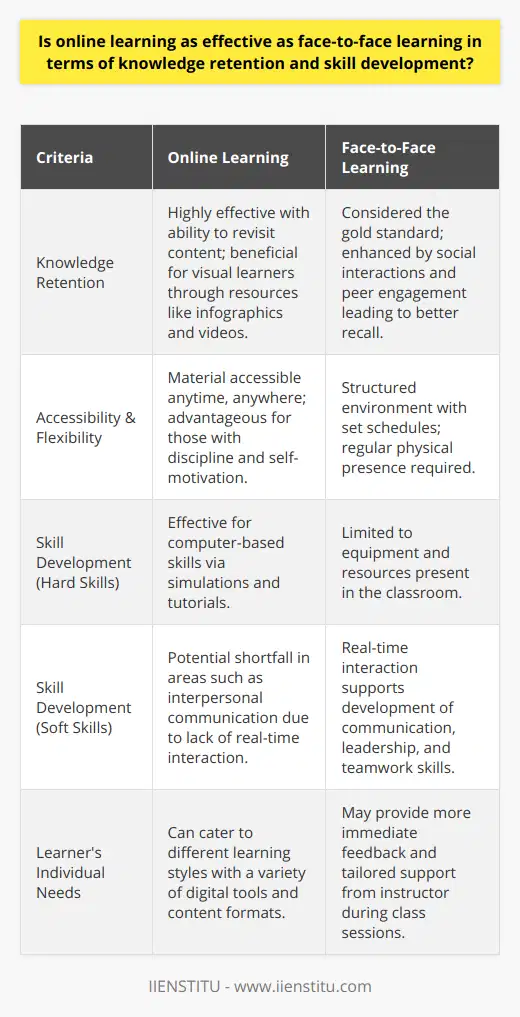
How does utilizing online resources in academic settings influence students' self-efficacy and motivation to learn?
Online Resources and Student Self-Efficacy
Online resources significantly augment students' self-efficacy. They provide students with opportunities to self-direct their learning. Students become more confident when they handle their academic tasks independently. Online resources also offer a variety of learning materials to cater to individual learning styles, enhancing students' belief in their capabilities.
Influence on Motivation to Learn
Online resources also boost students' motivation to learn. The interactive nature of these resources piques students' interest in the subject matter. Engaging multimedia tools amplify their understanding of complex topics. Online resources also facilitate immediate feedback, validation, and acknowledgment of progress, which further incentivizes learning.
Personalized Learning Opportunities
The personalized learning opportunities offered by online resources play a crucial role. Students learn at their pace, enhancing comprehension and retention. It reduces the pressure of keeping up with the group.
Peer Engagement and Collaboration
Furthermore, these resources allow for peer engagement and collaboration. It fosters a sense of community amongst learners. Peer discussions and cooperative learning stimulate students' motivation and drive a deeper understanding of the course content.
In conclusion, it is evident that online resources have a positive impact on students' self-efficacy and motivation to learn. Adopting them in academic settings can unquestionably improve students' learning experiences and outcomes.



